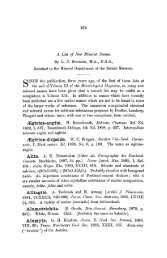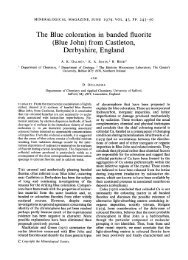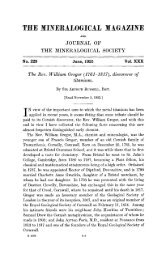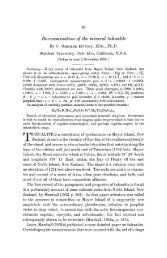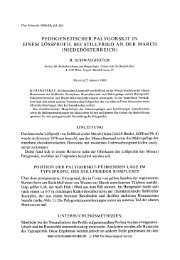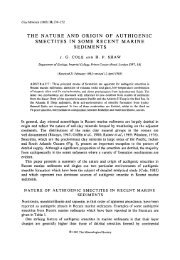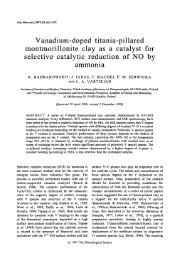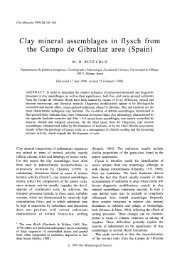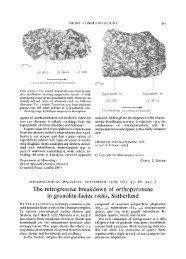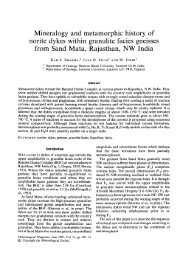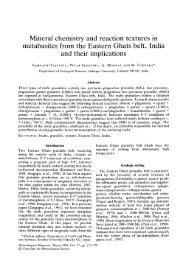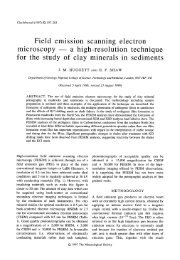weathering of glauconites - Mineralogical Society
weathering of glauconites - Mineralogical Society
weathering of glauconites - Mineralogical Society
You also want an ePaper? Increase the reach of your titles
YUMPU automatically turns print PDFs into web optimized ePapers that Google loves.
Clay Minerals (1981) 16, 231-243.<br />
WEATHERING OF GLAUCONITES: REVERSAL OF<br />
THE GLAUCONITIZATION PROCESS IN A<br />
SOIL PROFILE IN WESTERN FRANCE<br />
C. COURBE, B. VELDE* AND A. MEUNIER<br />
Laboratoire de Pddologie de l'Universitd de Poitiers, E.R.A. n ~ 220 du C.N.R.S., 40 avenue du Recteur Pineau,<br />
86022 Poitiers Cddex, and *Laboratoire de Pdtrographie de l'Universitd de Paris VI, 4 Place Jussieu 75230<br />
Paris Cddex 05, France<br />
(Received 24 November 1980)<br />
A BST RACT: Polarizing microscope, electron microprobe and X-ray diffraction examination <strong>of</strong><br />
minerals in a soil pr<strong>of</strong>ile developed on a gtauconite sand indicate that destabilization <strong>of</strong> glauconite<br />
can be a progressive process which appears to be the reverse <strong>of</strong> glauconitization. Glauconite in<br />
these soils appears to be destabilized into a mixed-layer glauconite-nontronite phase, which<br />
crystallizes as a plasma mineral. This material in turn is transformed into smectite+kaolinite<br />
+ oxides. Loss <strong>of</strong> K and Fe is evident in whole rock as well as microprobe analyses <strong>of</strong> the samples.<br />
Thus glauconite can lose both Fe and K to aqueous solution during <strong>weathering</strong>, leaving<br />
aluminous clay minerals in the soil.<br />
It has been noted that plants growing on glauconite-bearing subsoils in a sector <strong>of</strong> the<br />
Loire Valley vineyards in France (Chinon, Bourgueil, Saumur) do not show symptoms <strong>of</strong><br />
chlorosis. This suggests that soluble iron is available to the plants and that this iron comes<br />
from <strong>glauconites</strong> destabilized during <strong>weathering</strong>. The present investigation was under-<br />
taken to elucidate the chemistry <strong>of</strong> the destabilization process. The soil pr<strong>of</strong>ile studied (at<br />
Chace, near Saumur, Maine-et-Loire) was developed on a Turonian (Middle Cretaceous)<br />
sand which contained considerable quantities <strong>of</strong> glauconite.<br />
EXPERIMENTAL METHODS<br />
Samples from different parts <strong>of</strong> the soil pr<strong>of</strong>ile were treated in the following manner:<br />
(1) Whole rock analyses were made by flame and atomic absorption photometry<br />
(Jeanroy, 1972).<br />
(2) Glauconite grains were separated by electromagnetic means into magnetic and less<br />
magnetic fractions arbitrarily selected (Odin, 1969) within the grain size range 100-200<br />
#m.<br />
(3) X-ray diffraction traces (Co-K~) were obtained from samples treated with sodium<br />
dithionite/citrate (De Coninck & Herbillon, 1969) and saturated with K, Mg and Li<br />
(Robert & Tessier, 1974). Ethylene glycol was used to test the expandability <strong>of</strong><br />
Mg-saturated material.<br />
(4) Differential thermal analyses were carried out in order to determine the nature <strong>of</strong> the<br />
iron oxides and hydroxides.<br />
(5) Thin sections were made <strong>of</strong> samples from various parts <strong>of</strong> the pr<strong>of</strong>ile and after<br />
0009-8558/81/0900-0231502.00 9 1981 The Minerological <strong>Society</strong>
232 C. Courbe et al.<br />
examination using a polarizing microscope, chemical analysis <strong>of</strong> 2-3 #m diameter spots<br />
were made using a Cameca electron microprobe equipped with a Tracor-Northern<br />
solid-state detector and data treatment system. The beam current used at 15 kV excitation<br />
potential <strong>of</strong> the electron beam was 1-1.5 nA. This prevented alkali loss and breakdown <strong>of</strong><br />
the clay minerals concerned. Data were treated using a ZAF type program.<br />
Description <strong>of</strong> the pr<strong>of</strong>ile<br />
RESULTS<br />
Fig. 1 is a sketch <strong>of</strong> the pr<strong>of</strong>ile. The lowest zone is unaltered glauconite rock, fissured by<br />
oxidized and argillized material.<br />
Zone 1. The unaltered rock is a fine grained sand with 77.3% <strong>of</strong> the grains between 100<br />
and 200 #m in diameter. Glauconite comprises about 30% <strong>of</strong> the sand. Most <strong>of</strong> the<br />
glauconite is present as grains but a small portion occurs as glauconite matrix material<br />
~ ~ 411 ~ ~ --<br />
- - -- :3b _ - - _ _ - -<br />
a;<br />
=,.'...::...::%:<br />
10 c m<br />
%:..~c:: "'2")' '<br />
FtG. 1. Weathered pr<strong>of</strong>ile developed on glauconitic sand at Chace, near Saumur. Five zones are<br />
recognizable under an allochthonous layer <strong>of</strong> Tertiary sand (circles); a, b, c, d: colour or textural<br />
modifications inside the level as described in the text. Drawings at the side <strong>of</strong> zones 1 a, 3b, 4a and<br />
5d show the microstructure <strong>of</strong> each level. Q=quartz; G =glauconite; A= argillan; P=pore;<br />
GP = glauconite plasma; SAP = secondary argillaceous plasma.
Weathering <strong>of</strong> glauconite 233<br />
filling interstices. This green material is termed glauconite plasma <strong>of</strong> secondary origin.<br />
Zone 1 is subdivided into 1 a, the least altered horizon, which contains fissures lb and lc,<br />
and an ochre zone 1 d.<br />
Zone 2 (50 cm) is characterized by a yellow-brown colour which intensifies towards red<br />
hues in fractures. The grain size distribution is similar to that <strong>of</strong> zone 1.<br />
Zone 3 (40 cm) represents a transition between the lower and upper, argillized, portion<br />
<strong>of</strong> the pr<strong>of</strong>ile. This uppper part (3b) shows an increase in secondary argillaceous plasma<br />
materials, present as veinlets. It is brown in colour.<br />
Zone 4 (30 cm) is characterized by ferruginous concretions especially at the top (4b)<br />
where they represent about 159/0 <strong>of</strong> the sample; the clay fraction represents 25~ <strong>of</strong> the<br />
sample. Secondary veins <strong>of</strong> green glauconite plasma pervade the zone.<br />
Zone 5 (55 cm) shows prismatic structure. The clay content increases to 35~ <strong>of</strong> the<br />
sample and the general colour is less intense, contrasting with the green and red-brown<br />
hues <strong>of</strong> the lower zones.<br />
Photomicrographs <strong>of</strong> samples from different zones are shown in Fig. 2.<br />
In general, on moving up the pr<strong>of</strong>ile there is a decrease in quartz content and also in<br />
grain glauconite content, these changes being balanced by formation <strong>of</strong> the argillaceous<br />
plasma and, to a lesser extent, by an increase in porosity. These transformations are<br />
reflected in changes in the bulk composition at each level (Table 1).<br />
Three samples were chosen for detailed study following preliminary XRD examination<br />
<strong>of</strong> the glauconite and argillaceous portions <strong>of</strong> the pr<strong>of</strong>ile samples. These were the least<br />
altered sample (la), a sample from a horizon rich in glauconite plasma (4a), and a sample<br />
from the top <strong>of</strong> the pr<strong>of</strong>ile (5d), where alteration was well advanced.<br />
FIG. 2. Photomicrographs <strong>of</strong> <strong>glauconites</strong> and argillaceous plasma: (1) zone la, round-grain<br />
<strong>glauconites</strong>; (2) zone 3b, formation <strong>of</strong> glauconite plasma; (3) zone 4a, formation <strong>of</strong> secondary<br />
argillaceous plasma; (4) zone 5d, secondary argillaceous plasma and argillans. G = glauconite;<br />
Q = Quartz; Fk =potassic feldspar; M = Muscovite; GP =glauconite plasma; SAP = secondary<br />
argillaceous plasma; Ox = Oxide/hydroxide concretions; A = argillans.
234 C. Courbe et al.<br />
t~<br />
r<br />
0<br />
8
0<br />
@<br />
8<br />
,o<br />
.o<br />
<<br />
i<br />
Weathering <strong>of</strong> glauconite 235<br />
i<br />
~ 6 o ~ 6 6 6 6 o<br />
~ o o ~ o o 6 o o<br />
~.........~-~~<br />
~"~ 0 0 ~ 0 0 0 0 0<br />
6 6 6 : 6 6 6 6 6
236 C. Courbe et al.<br />
0<br />
b<br />
o<br />
u<br />
%a.<br />
.o~<br />
g~<br />
'N<br />
,-4<br />
9 o ~<br />
~ I ~ ~ -<br />
~6 ~ 6 6 o 6<br />
~Z I~ ~ I ~<br />
~1 ~ ~<br />
~ I z I ~oo~<br />
0<br />
~ o o 6666<br />
~ 6 6 6616<br />
~ & 6 6 6 6 6 6<br />
&~ 6 6 6 6 6<br />
~: o 6666<br />
&6 & 6 6 6 6<br />
&o = 6o 6<br />
~ I ~ I~oo~
0<br />
U<br />
~ 0 ~ I ~<br />
~ I ~ I~m~<br />
Weathering <strong>of</strong> glauconite 237<br />
~ IN INN In<br />
~~ I ~ 1 7 6<br />
0<br />
~ I~ I ~~<br />
~6 6666<br />
~66~ 6666<br />
~ 6 6 & 6 o 6 6 6<br />
~o &66666<br />
~ & 6 ~ 6 6 6 6<br />
~NNNN~N<br />
~ ~1 ~
238 C. Courbe et al.<br />
Least altered horizon ( la)<br />
This sample contained normal granular glauconite as well as secondary plasmic mica,<br />
both <strong>of</strong> which had a green colour under the microscope. A small portion had a fibrous<br />
appearance and higher birefringence. Microprobe analyses (Table 2) indicated that the<br />
minerals were rich in K atoms (0.5-0.7) while Fe atoms ranged from 1.10 to 1.30. XRD<br />
indicated 1Md+minor 1M polymorphs (Burst, 1958) and hence a disordered structure.<br />
There was a scatter in the composition <strong>of</strong> the <strong>glauconites</strong>, which appears to be normal for<br />
these minerals (Velde, 1976). A 15-20~ variation was noted between grain centres and<br />
edges. The centres tended to be rich in K and Fe. Some glauconite grains showed a brown<br />
colour but were not distinguished by either K20 or Fe203 contents. Even though they<br />
appeared altered and oxidized, they had not undergone significant chemical trans-<br />
formation.<br />
Zone <strong>of</strong> glauconite plasma (4a)<br />
Microscopic observation <strong>of</strong> this zone indicated that the glauconite grains destabilize to<br />
give a plasmic green glauconite and iron oxide/hydroxide concretions. Goethite appeared<br />
in X-ray patterns. In places the plasma was transformed into argillaceous matrix which<br />
contained highly birefringent platelets <strong>of</strong> clay minerals, sometimes oriented around<br />
quartz grains. Pore spaces were frequently coated with argillan material (Brewer, 1964).<br />
The glauconite grains had much the same composition as those in the less altered<br />
horizon 1 a (Table 3). Sometimes they contained more Fe, probably in hydroxide form.<br />
DTA curves indicated goethite (endotherm at 280~ and amorphous iron oxide<br />
(exotherm at 340~ XRD <strong>of</strong> separated grains showed slight structural differences when<br />
compared with material <strong>of</strong> the same electromagnetic properties from sample la. The<br />
diagnostic hkl reflections for the 1M structure were less evident and the 001 band was<br />
displaced to larger spacings. Thermogravimetric analyses indicated a 10.13~ weight loss<br />
compared to 8"46~o in sample la. Glauconite plasma was much more abundant than in<br />
sample 1 a and its composition was clearly less potassic and iron-rich than the glauconite<br />
grains in zone 1 a, or those still present in the sample. Several showing especially low K and<br />
Fe contents were probably mixtures <strong>of</strong> glauconite mixed-layer mineral (Burst, 1958) and<br />
another clay mineral.<br />
The less magnetic and non-granular material extracted represented, in large part, the<br />
argillaceous matrix. XRD showed smectite, kaolinite and some mica, this probably<br />
representing the destabilization <strong>of</strong> the mixed-layer glauconitic mineral. Microprobe<br />
analysis indicated further loss <strong>of</strong> K20 and Fe203 compared to glauconite grains and<br />
glauconite plasma (Table 3).<br />
Highly altered zone (5d)<br />
In this zone the glauconite grains and glauconite plasma were largely destabilized,<br />
being replaced by argillaceous plasma.<br />
The separated glauconite grains were more expandable than in the less altered zones.<br />
Weight losses <strong>of</strong> these grains were still greater than those from lower levels (12.18~o),<br />
indicating the presence <strong>of</strong> more expandable material; microprobe analyses showed lower<br />
K20 and Fe203 contents (Fig. 3, Table 4). The glauconite plasma also showed a potassium
e atom s<br />
..<br />
Weathering <strong>of</strong> glauconite<br />
o<br />
x<br />
x<br />
o<br />
o o x<br />
x o<br />
o OoO<br />
o<br />
0<br />
0<br />
05 Katoms<br />
FIG. 3 Fe/K composition <strong>of</strong> glauconite from zone 5d. Circles=green glauconite grains;<br />
crosses = brown glauconite grains; triangles = green glauconite plasma; dots = secondary argilla-<br />
ceous plasma.<br />
and iron loss. The argillaceous plasma contributed to the prismatic structure <strong>of</strong> the<br />
horizon. Analyses <strong>of</strong> this material suggested the presence <strong>of</strong> significant amounts <strong>of</strong><br />
kaolinite and iron oxides as well as smectite. XRD confirmed this but no pure kaolinite<br />
zones (AI = Si, lack <strong>of</strong> alkalis and iron) were found using the microprobe. Appreciable<br />
amounts <strong>of</strong> Ti (1~ as oxide) were contained in the iron concretions <strong>of</strong> zone 5b.<br />
Small amounts ( < 2~) <strong>of</strong> C 1 and S were found occasionally in the plasma zones. The<br />
secondary plasma zones nearest to the argillan material coating pore zones showed, in<br />
some instances, evidence <strong>of</strong> a micaceous or mixed-layer mineral which contained little Fe<br />
(Fig. 2). These zones contained minerals <strong>of</strong> high birefringence which were almost<br />
colourless or slightly yellow. Using the H<strong>of</strong>fman-Klemen test (1950) on fine clays from<br />
this zone, it was shown that the smectite present was montmorillonitic, in contrast to the<br />
beidellite-nontronite found in other parts <strong>of</strong> the pr<strong>of</strong>ile. Thus a new aluminous potassic<br />
mineral was formed during <strong>weathering</strong> in areas <strong>of</strong> high porosity.<br />
DISCUSSION<br />
The data indicate that there is a loss <strong>of</strong> K and Fe in the glauconitic materials towards the<br />
top <strong>of</strong> the <strong>weathering</strong> pr<strong>of</strong>ile. It is also evident that <strong>weathering</strong> changes the mineralogy<br />
progressively, i.e. glauconite (micaceous) is replaced by a mixed-layer phase then smectite<br />
plus kaolinite and oxides. Iron is concentrated in concretionary form in mid-pr<strong>of</strong>ile (zone<br />
4). The uppermost parts <strong>of</strong> the pr<strong>of</strong>ile contain little Fe, yet newly formed potassic minerals<br />
are present. A general increase in kaolinite content is noted.<br />
With the aid <strong>of</strong> the phase diagram proposed by Velde (1976) it is possible to construct a<br />
reasonably coherent sequence <strong>of</strong> events (Fig. 4). By placing the microprobe analyses for<br />
239
240 C. Courbe et al.<br />
u~<br />
0<br />
0<br />
b<br />
8<br />
,.D<br />
8<br />
<<br />
L~<br />
~ I ~ I~o~o<br />
o ~ gN2N<br />
~Z + ++e6<br />
~ ~ ~ I ~<br />
~ ~ ~ I ~<br />
r~<br />
8<br />
8<br />
m ~ o o 6 6 6 6<br />
. . . . ~ o ~<br />
~=~ ~<br />
~ 6 6 6 6 6 6
K20<br />
Weathering <strong>of</strong> glauconite<br />
MLAI - MLFe 13.0x<br />
o o MLFe<br />
~KaoI.N .Ox<br />
AI Fe<br />
FIG. 4. Composition <strong>of</strong> green and brown glauconite grains, glauconite plasma, secondary<br />
argillaceous plasma and argillans in zone la (dots), zone 4a (crosses) and zone 5d (circles) on<br />
K A1-Fe coordinate phase diagram (Velde, 1976). Mo=montmorillonite; N=nontronite;<br />
Ox=iron oxide; Kaol=kaolinite; MLal=aluminous mixed layered phase; MLFe=iron-rich<br />
mixed-layer phase; I = illite; G = glauconite.<br />
K, A1 and Fe as coordinates, a reasonably tight grouping <strong>of</strong> the original glauconite grains<br />
is seen, this being followed by a larger compositional spread for the green glauconite<br />
plasma. This new material contains a greater portion <strong>of</strong> expandable layers compared with<br />
initial sedimentary <strong>glauconites</strong> <strong>of</strong> the sand. The probe analyses <strong>of</strong> plasma material<br />
(smectite plus kaolinite and oxides) plot in a sector <strong>of</strong> the diagram which should contain<br />
these minerals. It is interesting to note that potassic minerals <strong>of</strong> high birefringence found<br />
in the secondary argillaceous plasma <strong>of</strong> the upper zone fall into the mixed-layer<br />
illite-montmorillonite compositional sector <strong>of</strong> the proposed phase diagram. Thus in some<br />
zones the activity <strong>of</strong> Fe in solution seems to be greatly diminished while potassium activity<br />
remains at a relatively high level in order to produce an aluminous illite or mixed-layer<br />
mineral. There seem to be zones in the upper levels <strong>of</strong> the pr<strong>of</strong>ile which have higher Fe<br />
activity in solution than others. Generally, the following sequence <strong>of</strong> mineral parageneses<br />
occurs as alteration becomes more intense:<br />
(i) glauconite;<br />
(ii) glauconite + mixed-layer glauconite + iron oxide;<br />
(iii) smetite + kaolinite + Fe, Ti-oxide or mixed-layer glauconite + aluminous mixed-layer<br />
illite mineral.<br />
CONCLUSION<br />
The most significant point to emerge from the present investigation is the progressive<br />
change in glauconite mineralogy which produces mixed-layer minerals similar to those<br />
encountered in sedimentary <strong>glauconites</strong>. Other workers (e.g. Wolff, 1967) have shown<br />
that <strong>weathering</strong> <strong>of</strong> glauconite produces a kaolinite+ oxide reaction product. Yet the<br />
pr<strong>of</strong>ile studied here gives a sequence which is the reverse <strong>of</strong> glauconitization (Hower,<br />
241
242 C. Courbe et al.<br />
1961; Velde, 1976). This suggests that glauconitization is a reversible process under<br />
low-temperature conditions and thus should be considered as a stable reaction or at least<br />
a reversible metastable reaction.<br />
The result <strong>of</strong> glauconite <strong>weathering</strong> in the pr<strong>of</strong>ile is to release K and Fe ions into the<br />
altering solution. These solutions react to produce new mixed-layer minerals in a<br />
step-wise process which gives an iron-rich or aluminous trend depending upon the<br />
position in the rock fabric. Materials in close contact with glauconitic minerals change<br />
into nontronitic minerals while those near pores, in closer proximity to solutions from the<br />
surface, produce iron-poor phases. Two mineral trends are then evident as shown in<br />
Fig. 3. Much Fe is lost to solution as shown by bulk 'rock' analyses.<br />
Returning to the initial observation concerning the vineyards: since glauconitic<br />
<strong>weathering</strong> in these pr<strong>of</strong>iles releases iron to the solutions, this can be incorporated by the<br />
plants thus preventing chlorosis. It is necessary that the roots <strong>of</strong> the plants reach levels just<br />
above the glauconitic plasma zone where iron release is greatest. Also, the high potassium<br />
activity should be beneficial to the plants and thus one might consider <strong>glauconites</strong> as a<br />
natural mineral fertilizer, at least for vineyards.<br />
REFERENCES<br />
BPJ~WER R. (1964) Fabric and Mineral Analysis <strong>of</strong> Soils, p. 470. Wiley, London.<br />
BURST, J.F. (1958) Mineral heterogeneity in glauconite pellets. Am. Miner. 43, 481-497.<br />
DE CONINCK F. & HFa~BILLON A.J. (1969) Evolution min~ralogique et chimique des fractions argileuses dans les<br />
alfisols et spodosols de la Campine (Belgique). Pedologie XIX, 159-272.<br />
HOFF~AN U. & KLEIN R. (1950) Verlust der Austanochf~ihigkeit yon Lithiumionen an bentonit durch<br />
Erhitzung. Zeitsch. anorg, chem. 262, 95-99.<br />
HOWEg J. (1961) Some factors concerning the nature and origin <strong>of</strong> glauconite. Am. Miner. 47, 886-896.<br />
JEANROV E. (1972) Analyse totale des silicates naturels par spectrophotom6trie d'absorption atomique.<br />
Application au sol et ~ ses constituants. Chimie Analytique 54, 159-166.<br />
OolN G.S. (1969) M~thode de s~paration des grains de glauconie. Int6r~t de leur ~tude min6ralogique et<br />
structural. Rev. Gdol. Phys. Gdol. Dynam. XI, 171-176.<br />
ROBERT M. & TESSIER D. (1974) M6thode de pr6paration des argiles des sols pour les 6tudes min6ralogiques.<br />
Ann. Agron. 25, 859-882.<br />
VERDE B. (1976) The chemical evolution <strong>of</strong> glauconite pellets as seen by microprobe determinations. Miner.<br />
Mag. 40, 753-760.<br />
WOLFF R.G. (1967) X-ray and chemical study <strong>of</strong> <strong>weathering</strong> glauconite. Am. Miner. 52, 1129-1138.<br />
Rl~SUM]~: Les observations microscopiques, les analyses/t la microsonde et les d~terminations<br />
par diffractions de rayons-X sur un sol d~velopp~ sur un sable glauconieux, indiquent que la<br />
d~stabilisation de la glauconie intervient progressivement suivant le processus inverse de la<br />
glauconitisation. Elle s'alt~re en dormant un interstratifi~ glauconie--nontronite qui cristallise<br />
dans un plasma glauconieux. I1 se transforme/L son tour dans un plasma secondaire argileux<br />
compos6 de smectite + kaolinite + oxyde. La perte de potassium et de fer au niveau de la glauconie<br />
entralne la formation de phases argileuses alumineuses darts le sol.<br />
KURZREFERAT: Die Untersuchung yon Mineralen in einem aus Glaukonitsand entwick-<br />
elten Bodenpr<strong>of</strong>il mittels Polarisations-mikroskopie, Elektronenmikrosonde und R6ntgenbeu-<br />
gungsanalyse zeigt, dab die Glaukonitzersetzung als ein fortschreitender Prozel3 gesehen werden<br />
kann, der scheinbar in Umkehrung zur Glaukonitbildung abl/iuft. Offensichtlich wandelt sich der<br />
Glaukonit dieser B6den in eine wechselgelagerte Glaukonit-Nontronit Phase urn, die als<br />
glaukonitisches Plasma auskristallisiert. Im weiteren Verlauf wird dieses Material in Smectit+<br />
Kaolinit+Oxide umgebildet. Ein Verlust an K und Fe ist im Ausgangsgestein ebenso<br />
<strong>of</strong>fensichtlich wie in den Mikrosondenanalysen der Proben. Daher kann Glaukonit Fe und K im<br />
Zuge der Verwitterung in w/issrige L6sung abgeben und dem Boden aluminiumhaltige<br />
Tonminerale hinterlassen.
Weathering <strong>of</strong> glauconite<br />
RESUMEN: E1 examen de un perfil de suelo desarrollado sobre una arena glauconitica a trav6s<br />
del microscopio de polarizaci6n, microsonda electr6nica y difracci6n de R-X indica que la<br />
desestabilizaci6n de la glauconita es progresiva siguiendo un proceso inverso al de la<br />
glauconitizaci6n. La glauconita se altera dando lugar a un interestratificado glauconita-non-<br />
tronita que cristaliza en un plasma glauconitico que se transforma, a su vez, en una mezcla<br />
compuesta pot smectita, kaolinita y 6xidos. La p6rdida de potasio y hierro por parte de la<br />
glauconita conlleva a la formaci6n de fases aluminicas en el suelo.<br />
243



